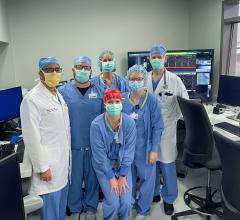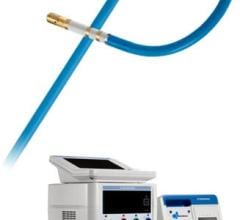February 28, 2012 — nContact Inc. announced a new preclinical study examining a unique minimally invasive percutaneous approach to accessing the heart that may enable electrophysiologists (EPs) to perform epicardial ablation for ventricular tachycardia (VT). The study was published in the February 2012 issue of The Journal of Innovations in Cardiac Rhythm Management.
In the study, “Creating Transmural, Linear Epicardial Ablation Lesions via a Non-surgical, Percutaneous, Subxyphoid, Electrogram-guided Approach,” researchers sought to modify an existing epicardial ablation device’s (nContact’s EPi-Sense Guided Coagulation Device with VisiTrax) transdiaphragmatic approach to a percutaneous subxyphoid (below the sternum) approach that could enable epicardial ablation without requiring a more invasive surgical access. The EPi-Sense system has been used clinically in Europe for the treatment of atrial fibrillation and investigators in this study suggest it may also be suitable for the treatment of sinus tachycardia and challenging VT.
“In this study, we examined for the first time a truly minimally invasive, ‘incisionless’ approach to performing epicardial ablation. Clinical experience has shown that VT and other arrhythmias originating on the epicardial aspect of the heart may not respond to endocardial ablation, suggesting the need for less invasive tools designed to create lesions on the epicardium,” said lead investigator Miguel Valderrábano, M.D., FACC, of The Methodist Hospital in Houston. “While further studies are needed on the applicability of this technique in clinical electrophysiology, our findings suggest it may expand the capabilities of EP-guided ablation and offer promising clinical utility in addressing VT.”
For this preclinical study, researchers performed epicardial ablation on six pigs with a percutaneous subxyphoid puncture access. Under fluoroscopy, a guide wire was advanced through the needle puncture into the pericardial space and the subcutaneous tissue was dilated with an angioplasty balloon, allowing physicians to advance the EPi-Sense device into the pericardium without endoscopy or surgical tools. Utilizing fluoro-imaging and mapping diagnostics, physicians were able to position the device by manipulating the wire, and tissue contact was verified by sensing electrodes embedded in the device’s ablation coil. Epicardial ablation was then performed on both atria and both ventricles, with explanted hearts confirming the accuracy of lesion locations and consistent lesion transmurality.
“We are pleased that our technology is facilitating continued physician innovation in cardiac ablation and potentially opening new avenues for the epicardial treatment of VT,” said John Funkhouser, president and CEO of nContact. “We are continuing to innovate and lead the epicardial ablation space with easier ‘incisionless’ access and sensing capabilities in our device to allow electrophysiologists to map the precise location of our device in order to properly position the device on the ventricle.”
For more information: www.ncontactinc.com


 October 30, 2024
October 30, 2024 








